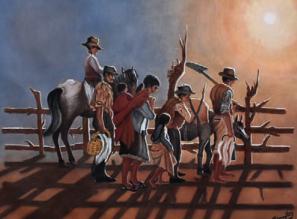Strengthening Ties through Art
2018-07-12ByABELROSALESGINARTE
By ABEL ROSALES GINARTE

FINE Arts schools in Peru, China, and Mexico recognize the talent of Ernesto Apomayta Chambi, who said goodbye to his native Puno of Peru in 1984 to study traditional Chinese paintings, calligraphy, and learn the Chinese language. During his years at the Central Academy of Fine Arts in Beijing, he discovered a deep connection between the original peoples of Peru and China. “When I arrived in Beijing, I felt that the pictograms on the streets and the phonetics of the language were similar to those of my Aymara people.”Apomayta is a descendant of the Quechua and Aymara peoples of the Andean regions of Peru. His first inspiration to learn to draw came from the impressive images from Lake Titicaca and the Incan citadel of Machu Picchu. “The colored pencils and the paper have been driving me through life, helping me express my telluric feeling through my works and tonalities.”
Assured that the indigenous traditions of his original people of Puno, Acora, a district of the Puno Province, were born from the fusion between Asian and Western cultures, Apomayta says, “The legacy of Asia runs in my veins.” Among the many cultural and social similarities, the music stands out the most. “Andean music is composed, much like Chinese music, using the pentatonic scale. The metric and the singing are especially similar to the southern Andean regions of Cusco and Ayacucho.” This is validated by the renowned Peruvian musician Lucho Quequezana, who, thanks to the support of UNESCO, was able to provide a unique musical performance with instrumentalists from several countries, which he called Sonidos vivos.
“Between the Tibetans of China and the Aymaras of Peru and Bolivia, there are strong coincidences in the phonetics, in the ways of dressing, and how they make their colorful garments,” he adds. Apomayta states that nature, atmospheric and cosmic phenomena occupy a unique space in Chinese and American original cultures. “The earth, the sky, the sun, the moon, the stars, the sea, and the rivers, the clouds, the wind and the rain, do not represent the objective reality. They are, as shown by the epithets that characterize them, ‘brothers of the inhabitants and ‘living beings who deserve respect.”
For Unity and World Peace
Fascinated with China, Apomayta defends the deep cultural and social connection, “In the north of Peru, the names of many towns, rivers, and cemeteries are similar to Chinese names, such as the famous Huaca Cao archaeological site, the Chao River and the cities of Bagua and Yupán.” He states that the learning process of Mandarin, for those who understand Quechua and Aymara, with the help of Chinese teachers, is easier than for those who only speak Spanish.“The phonetics of the native languages significantly helped me master the Chinese language. Many of those words are pronounced similar to Mandarin Chinese, albeit with different meanings.”
This shows the value in having Chinese students who learn Spanish and other ancestral languages, such as Quechua, and Latin American students who study Mandarin Chinese, carry out international cultural exchanges“to better assimilate the learning of languages and cultures.” Apomayta advises students to persevere and strive to ensure a smooth cultural exchange. His paintings express the spirit of unity and world peace. “One of my first works was on rice paper showing the unity of the wonders that are Machu Picchu and the Great Wall.”
After having lived on four continents and combining his artistic work with teaching, he feels satisfied. In his native Peru, he has worked as a Mandarin Chinese teacher at the Southern Peruvian University of Cusco: “I taught basic to intermediate levels to university students.” He also worked at the Andean University of Cusco teaching the same levels. At the Autonomous Superior School of Fine Arts Diego Quispe and the Public School of Art Carlos Baca Flor of Arequipa, he worked as a teacher of traditional Chinese painting. He also worked as a teacher in Salt Lake City, Utah in the U.S. “I taught drawing and painting theory to children to help them discover and express natural talent and creativity through various methods and materials.”
A Second Homeland
Apomayta travels to all parts of the world sharing his Andean roots. “A few years ago, I was very shy, withdrawn, and it was very difficult for me to speak in public. But an excellent Chinese mentor named Li Keren motivated me to read, making me understand that if my mind was nourished, I would be able to speak and defend myself orally wherever I went.” His stay in China has provided him with many fond memories. He liked the Chinese language so much that he learned them by “writing the characters and reading Chinese grammar in a dictionary.”
Currently, his professional career is focused on writing and painting: “Both go hand in hand. The Incas said that writing is like painting and painting is like writing, so for me it makes a lot of sense.” He remembers all his Chinese teachers with great affection, “The Central Academy of Fine Arts was truly my second home, a place of dreams that I remember fondly, so I am excited to talk about that time in China.”
What began as a friendly approach to oriental art, culminated in an attraction for the aesthetics of that region.“What most surprised me about most of Chinese paintings, is the mystical attitude that is perceived behind the mists, mountains, and the rivers of Taoist Chinese landscape,” Apomayta said. Alongside his advanced postgraduate studies in traditional Chinese painting, he has added a masters degree in visual arts from the National Autonomous University of Mexico. His unlimited versatility makes him an authority on Chinese pictorial art in his country.
Countless awards and recognitions distinguish his work. In 2000, the National Institute of Culture of Peru recognized him as an Outstanding Professional Painter. The mayor of the city of Santa Ana, California, awarded him for his performance in the creativity and innovation of the visual arts. In 1987, CCTV (China Cenral Television) held a Chinese language contest and Apomayta took second place among 350 foreigners from around the world.
He has held solo exhibitions in the U.S., Canada, China, Peru, and Mexico. “I had the opportunity to be in China, which I consider my second homeland, in the middle of the 2008 Olympic Games, and I moved to Shanghai where I lived for a long time.” On one occasion he visited Suzhou, the so-called “Venice of the East,”“which not only dazzled me but also inspired me to reproduce its charming landscapes on paper and canvas.”
China is a constant in his life and in his art. “I hope to return to Beijing to paint a great mural that reflects the lasting friendship of the peoples of Peru and China.” And that great mural will unite two historical monuments and wonders of the modern world: the Great Wall and Machu Picchu.
